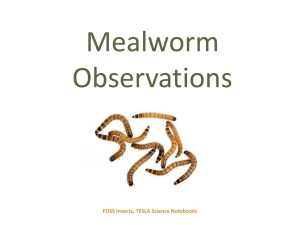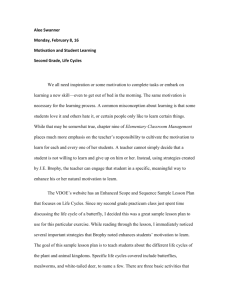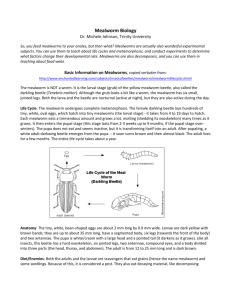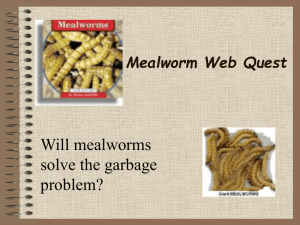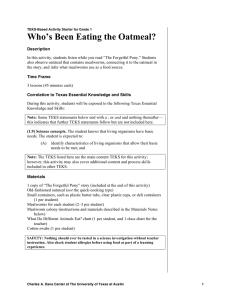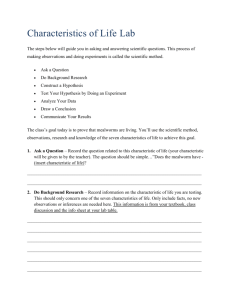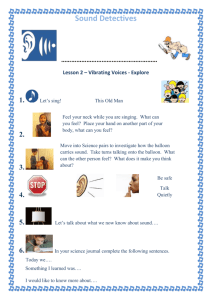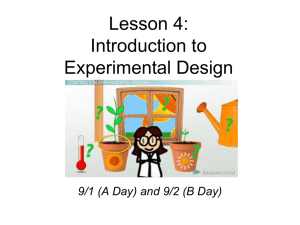More Lizard Snacks
advertisement
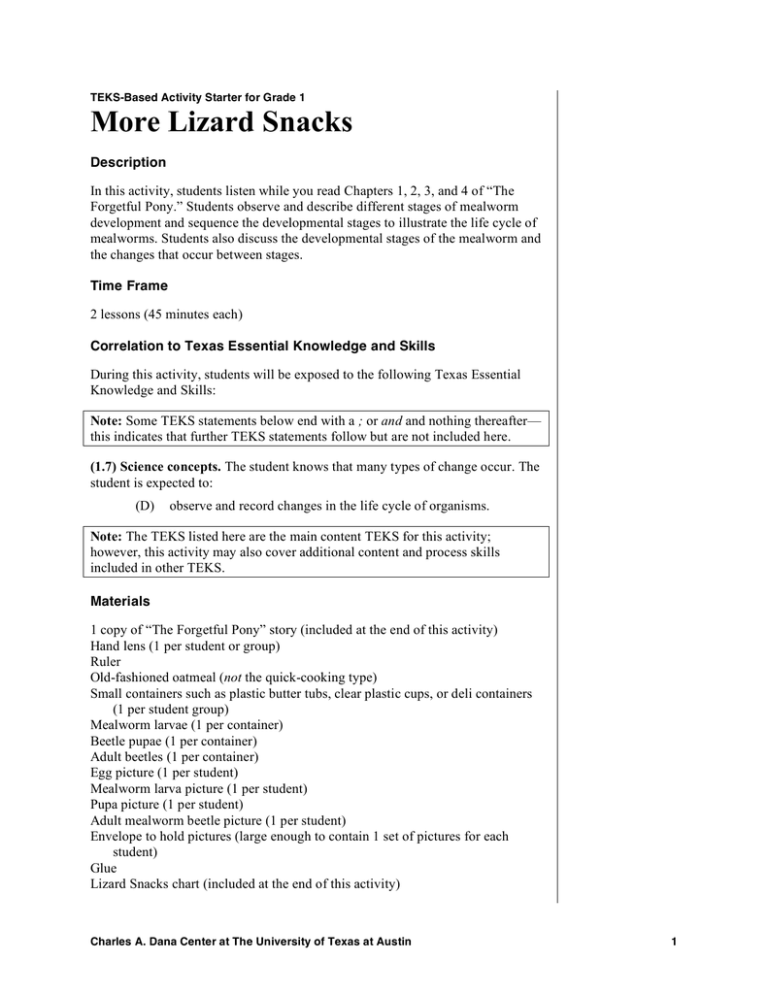
TEKS-Based Activity Starter for Grade 1 More Lizard Snacks Description In this activity, students listen while you read Chapters 1, 2, 3, and 4 of “The Forgetful Pony.” Students observe and describe different stages of mealworm development and sequence the developmental stages to illustrate the life cycle of mealworms. Students also discuss the developmental stages of the mealworm and the changes that occur between stages. Time Frame 2 lessons (45 minutes each) Correlation to Texas Essential Knowledge and Skills During this activity, students will be exposed to the following Texas Essential Knowledge and Skills: Note: Some TEKS statements below end with a ; or and and nothing thereafter— this indicates that further TEKS statements follow but are not included here. (1.7) Science concepts. The student knows that many types of change occur. The student is expected to: (D) observe and record changes in the life cycle of organisms. Note: The TEKS listed here are the main content TEKS for this activity; however, this activity may also cover additional content and process skills included in other TEKS. Materials 1 copy of “The Forgetful Pony” story (included at the end of this activity) Hand lens (1 per student or group) Ruler Old-fashioned oatmeal (not the quick-cooking type) Small containers such as plastic butter tubs, clear plastic cups, or deli containers (1 per student group) Mealworm larvae (1 per container) Beetle pupae (1 per container) Adult beetles (1 per container) Egg picture (1 per student) Mealworm larva picture (1 per student) Pupa picture (1 per student) Adult mealworm beetle picture (1 per student) Envelope to hold pictures (large enough to contain 1 set of pictures for each student) Glue Lizard Snacks chart (included at the end of this activity) Charles A. Dana Center at The University of Texas at Austin 1 TEKS-Based Activity Starters Grade 1—More Lizard Snacks Materials Notes Grain and Mealworms Grain elevators, feed and flour mills, barns, and grain product warehouses may become home for grain-eating insects, such as darkling beetles, grain beetles, cosmopolitan beetles, and flour beetles. These beetles undergo complete metamorphosis, which means they go through four distinctive stages of development—egg, larva, pupa, and adult. The eggs are white, bean-shaped, and about 1/20 inch long. Very tiny white larvae hatch from the eggs. In the larval stage, the darkling beetle is called a mealworm. As the mealworms grow, they molt, or shed their hard outer skeleton, up to 14 times. The larvae of yellow mealworms (Tenebrio molitor) are honey-yellow in color, while the larvae of darker mealworms (Tenebrio obscurus) are dark brown. A mature mealworm becomes darker just before it turns into a pupa. During the pupa stage, the larva acquires adult beetle characteristics. After the changes are complete (from one to three weeks), a light-colored adult beetle emerges. The beetle’s color darkens as it matures. Beetles are adults and do not grow; therefore, they do not molt. Adult beetles live from four to five weeks. The mature female beetle will lay from 270 to 500 eggs. The eggs generally hatch in about two weeks. The length of time required to complete the life cycle depends on environmental conditions such as temperature and food supply. Mealworms do best in temperatures between 80–90°F. At temperatures between 40–50°F the mealworms will become dormant. Lower temperatures will kill them. To establish a mealworm colony, assemble the following materials: 1 large clear, dry, glass or hard plastic container, such as a one-gallon jar, a plastic storage box, or an aquarium Note: Containers with a wide surface area encourage mealworm growth. Do not use cardboard or a paper or plastic bag, as the mealworms will eat through it. Old-fashioned oatmeal (not the quick-cooking type) Bran flakes (2–3 cups) 1 or 2 slices of raw potato or apple Approximately 100 mealworm larvae (available at most pet stores) 1 colander sieve (openings should be small enough that the mealworms will not pass through) Set up the mealworm colony at least two weeks before conducting this activity. 1. Place a two-inch-deep layer of oatmeal mixed with bran flakes in a large container. Do not fill the container to the top, or the larvae will crawl out. 2. Place a thick slice of raw potato or apple on the oatmeal mixture to supply the larvae with water. 3. Add the mealworm larvae. Charles A. Dana Center at The University of Texas at Austin 2 TEKS-Based Activity Starters Grade 1—More Lizard Snacks 4. Check the water source about once a week. Replace it with a fresh piece of potato or apple if the slice becomes hard, dry, or moldy. 5. After a few weeks a noticeable gray powder, called frass, will appear on the floor of the container. Dump the contents of the container into a household sieve. Mealworms, adult beetles, and uneaten oatmeal will be retained, and the frass will fall through the sieve. Frass is composed of mealworm wastes and eggs. You may want to keep the frass to raise more mealworms. 6. Clean and thoroughly dry the container. 7. Add a fresh food supply of oatmeal and bran flakes and return the mealworms, adult beetles, and uneaten oatmeal to the container. Add a fresh slice of apple or potato as a water source. Responsible Use of Live Animals in the Science Classroom These guidelines are part of the National Science Teachers Association’s Position Statement “Responsible Use of Live Animals and Dissection in the Science Classroom,” adopted by the NSTA Board of Directors in June 2005. The full statement is available online at www.nsta.org/positionstatement&psid=44. NSTA supports the decision of science teachers and their school or school district to integrate live animals and dissection in the K–12 classroom. Student interaction with organisms is one of the most effective methods of achieving many of the goals outlined in the National Science Education Standards (NSES). To this end, NSTA encourages educators and school officials to make informed decisions about the integration of animals in the science curriculum. NSTA opposes regulations or legislation that would eliminate an educator's decisionmaking role regarding dissection or would deny students the opportunity to learn through actual animal dissection. NSTA encourages districts to ensure that animals are properly cared for and treated humanely, responsibly, and ethically. Ultimately, decisions to incorporate organisms in the classroom should balance the ethical and responsible care of animals with their educational value. While this position statement is primarily focused on vertebrate animals, NSTA recognizes the importance of following similar ethical practices for all living organisms. Including Live Animals in the Classroom NSTA supports including live animals as part of instruction in the K–12 science classroom because observing and working with animals firsthand can spark students' interest in science as well as a general respect for life while reinforcing key concepts as outlined in the NSES. NSTA recommends that teachers • Educate themselves about the safe and responsible use of animals in the classroom. Teachers should seek information from reputable sources and familiarize themselves with laws and regulations in their state. Charles A. Dana Center at The University of Texas at Austin 3 TEKS-Based Activity Starters Grade 1—More Lizard Snacks • Become knowledgeable about the acquisition and care of animals appropriate to the species under study so that both students and the animals stay safe and healthy during all activities. • Follow local, state, and national laws, policies, and regulations when live organisms, particularly native species, are included in the classroom. • Integrate live animals into the science program based on sound curriculum and pedagogical decisions. • Develop activities that promote observation and comparison skills that instill in students an appreciation for the value of life and the importance of caring for animals responsibly. • Instruct students on safety precautions for handling live organisms and establish a plan for addressing such issues as allergies and fear of animals. • Develop and implement a plan for future care or disposition of animals at the conclusion of the study as well as during school breaks and summer vacations. • Espouse the importance of not conducting experimental procedures on animals if such procedures are likely to cause pain, induce nutritional deficiencies, or expose animals to parasites, hazardous/toxic chemicals, or radiation. • Shelter animals when the classroom is being cleaned with chemical cleaners, sprayed with pesticides, and during other times when potentially harmful chemicals are being used. • Refrain from releasing animals into a non-indigenous environment. Advance Preparation 1. Prepare a small plastic container of oatmeal that includes a mealworm larva, pupa, and adult beetle for each student or group of students. 2. Prepare an envelope containing labeled pictures of the egg, mealworm larva, pupa, and adult beetle for each student. 3. Make a large copy of the Lizard Snacks chart and post it on the board. Note: You may want to let students work in groups of 2–3 when observing the containers of larvae, pupae, and adult beetles, but be sure to prepare an envelope with all four pictures for each student. Procedures 1. Read aloud to students “The Forgetful Pony.” Charles A. Dana Center at The University of Texas at Austin 4 TEKS-Based Activity Starters Grade 1—More Lizard Snacks 2. Ask students why the lizard says there will be more snacks in a few weeks, even if the lizard eats all of the mealworms today. Allow them to make as many hypotheses as they can. 3. Give student groups containers that hold a mealworm larva, pupa, and adult. Explain that all these organisms were found in the oatmeal only after larvae were placed in the oatmeal and allowed to undergo life cycle changes for many weeks. Show the mealworm colony to the students. They should be able to observe three life cycle stages present in the colony. 4. Give students hand lenses, and ask them to observe the organisms in their containers and to compare and contrast the different life cycle stages they see. Use questioning strategies to help them focus on similarities and differences in each stage. How are the organisms alike? How are they different? Note: Although students should not remove any organisms from the containers, remind students of the need to treat living creatures humanely. 5. Lead the class to realize that all these organisms are the same type of organism in different life cycle stages instead of three different organisms. 6. As students consider life cycle stages in the mealworm and in other organisms, you may want to ask questions such as, Which stage do you think comes first? Second? Third? One stage is missing; which do you think it is? Why do you think you weren’t given an egg to observe? Can you name other animals that have different life cycle stages? Note: Students may know animals such as butterflies, dragonflies, houseflies, and frogs go through several stages before becoming adults. Ask students at which stage they think animals lay their eggs. Some students will know that animals lay eggs at the adult stage. A common misconception is that the droppings from caterpillars, mealworms, and other larvae are eggs. Be sure students understand that larvae cannot lay eggs. Remind students that the eggs of the mealworm are very difficult to see because they are very small. 7. Give students the envelopes containing labeled pictures of the stages of mealworms. 8. Have students compare pictures of the mealworm stages to the real organisms and discuss the names of the stages. Guide students to place the stages in the correct order and have them record this on their Lizard Snacks charts. 9. Discuss the changes that occur at each stage, including color, size, and movement. Help students record their observations on their Lizard Snacks charts. Measure the larvae, pupae, and adult beetles and record Charles A. Dana Center at The University of Texas at Austin 5 TEKS-Based Activity Starters Grade 1—More Lizard Snacks measurements on the board. Have students copy the measurements next to the appropriate stages on the chart. 10. Return the mealworms to the colony, and keep the colony and plastic containers for use in other activities that require a mealworm colony. If none such activities are planned, discreetly place the mealworms in a plastic bag and freeze them. Once frozen, you can dispose of the bag. Additional Resources Following is a list of books useful for providing students informative and interesting facts about insect life. Himmelman, John. A Mealworm’s Life (Nature Upclose). Connecticut: Children’s Press, 2001. Litowinsky, Olga. Groovy Tube Books: Bug Blast! Norwalk: Innovative Kids, 2000. Charles A. Dana Center at The University of Texas at Austin 6 TEKS-Based Activity Starters Grade 1—More Lizard Snacks Assessment Use a blank Lizard Snacks chart and have students independently arrange and glue the pictures in the correct sequential order in the life cycle column. They should also answer the open-ended statement under the chart. Use the following rubric to evaluate students’ work. Level 4 Level 3 Level 2 Level 1 Thoroughness Clarity Accuracy Reasoning The life cycle is complete. Observations include measurements, descriptions of movements, and descriptions using each of the senses. The pictures are placed in a logical order. Observations are organized. The life cycle and its labels are accurate. Measurements are accurate to the nearest centimeter. The student clearly understands that mealworms are being produced all the time. Thoroughness Clarity Accuracy Reasoning The life cycle is complete. Observations include measurements and descriptions using each of the senses. The pictures are placed in a logical order. Observations are organized. The life cycle and its labels are accurate. Measurements have been made. The student understands that mealworms are present at times. Thoroughness Clarity Accuracy Reasoning The life cycle is complete. Observations include descriptions using each of the senses. The pictures are not placed in a logical order. Observations are organized. The life cycle and its labels are not accurate. Measurements are not accurate. The student understands only that mealworms are present. Thoroughness Clarity Accuracy Reasoning The life cycle is not complete. No complete observations are recorded. The pictures are not placed in a logical order. Observations are disorganized. The life cycle and its labels are not accurate. The student does not understand that mealworms are being produced all the time. Charles A. Dana Center at The University of Texas at Austin 7 TEKS-Based Activity Starters Grade 1—More Lizard Snacks The Forgetful Pony Once upon a time there was a forgetful pony. The forgetful pony wanted to make some oatmeal cookies. “I do not know anything about oat grains. Who will help me gather some grains of oats to make oatmeal cookies?” neighed the forgetful pony. “Not I,” mooed the cow. “Not I,” baahed the sheep. “Not I,” cooed the dove. “Not I,” hissed the little green lizard. “I do not like oatmeal cookies. But I will show you some oat grain.” So the little green lizard went to the field and showed the pony the oat grains. Then the forgetful pony gathered the grain by himself. “I do not know how to make oatmeal. I don’t even know what oatmeal looks like,” neighed the forgetful pony. “Who will help me make the oatmeal for the oatmeal cookies?” “Not I,” mooed the cow. “Not I,” baahed the sheep. “Not I,” cooed the dove. “Not I,” hissed the little green lizard. “I do not like oatmeal cookies. But I will show you how to make the oatmeal.” So the little green lizard showed the forgetful pony how to roll the oat grains into oatmeal. “See, this is what oatmeal should look like,” said the little green lizard. Then the forgetful pony rolled the oat grains and made the oatmeal himself. “That was a lot of work,” thought the forgetful pony. “I will put the oatmeal in the barn. I can make the oatmeal cookies tomorrow.” Of course, when tomorrow came, the forgetful pony forgot where he had put the oatmeal. Many weeks went by, and the forgetful pony could not remember where he put the oatmeal. But one day the forgetful pony neighed loudly, “I remember where the oatmeal is! I will make oatmeal cookies today. Who will help me eat the oatmeal cookies?” “I will,” mooed the cow. “I will,” baahed the sheep. “I will,” cooed the dove. “Not I,” hissed the little green lizard, “I do not like oatmeal cookies. But I will go to the barn with you to get the oatmeal.” So all of the animals went to the barn to get the oatmeal for the oatmeal cookies. “Who’s been eating the oatmeal?” neighed the forgetful pony when he saw some of the oatmeal was missing. “Not I,” mooed the cow. “Not I,” baahed the sheep. “Not I,” cooed the dove. “Well, I did not,” hissed the lizard, “I do not like oatmeal. But I know who did eat it!” And the lizard had a snack right there and then. The lizard hissed happily as he snacked, “There will be even more snacks for me to eat in a few weeks.” Charles A. Dana Center at The University of Texas at Austin 8 TEKS-Based Activity Starters Grade 1—More Lizard Snacks Lizard Snacks Life Cycle Stage Color Size Movement The lizard will have more snacks because Charles A. Dana Center at The University of Texas at Austin 9

